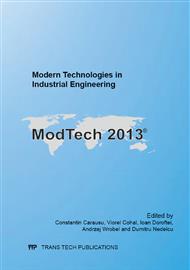p.3
p.9
p.16
p.22
p.28
p.33
p.39
p.43
A Study on Plastic Deformations due to Contact Fatigue Wear on a Metallic Coating Deposed in Electric Arc
Abstract:
This paper studies the way how a sample with a 40Cr130 coating behaves to contact fatigue wear from the perspective of plastic deformations. The sample is made of an 18MnCr11 alloy steel. The coating was deposited in electric arc using the Smart Arc 350 installation from Sulzer Metco. The samples was subjected to fatigue wear on the AMSLER installation in limit and mixed lubrication conditions. The samples were subjected to wear for 30 hours, at a loading force of 177 N. The moving sample had a rotational speed of 375 rot/min. Different combinations of contact materials were used for the test samples: coating coating and coating base material. The results were highlighted using the QUANTA 200 3D DUAL BEAM electron microscope.
Info:
Periodical:
Pages:
9-15
Citation:
Online since:
November 2013
Keywords:
Price:
Сopyright:
© 2014 Trans Tech Publications Ltd. All Rights Reserved
Share:
Citation:


